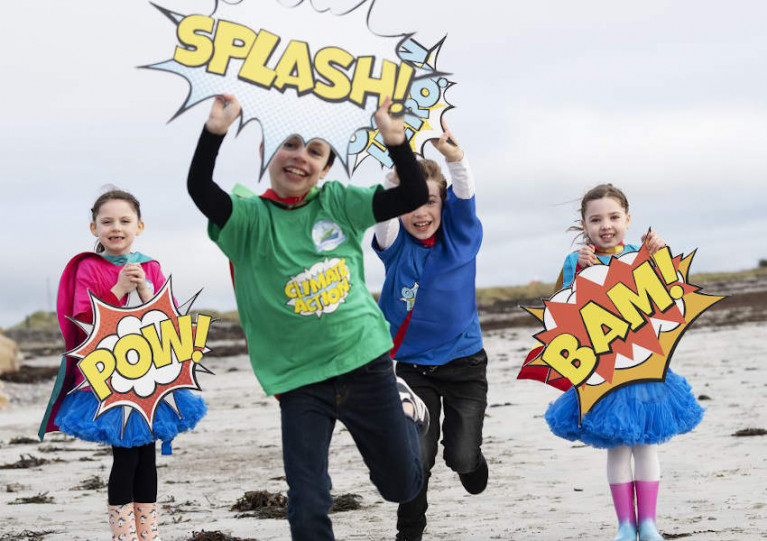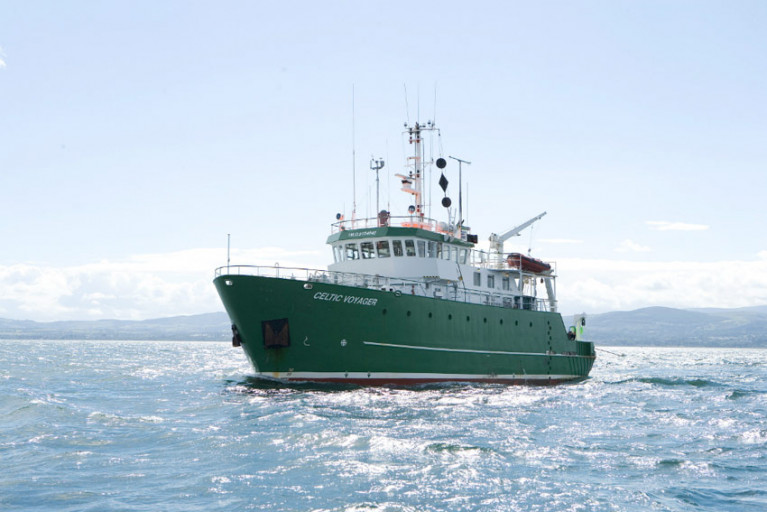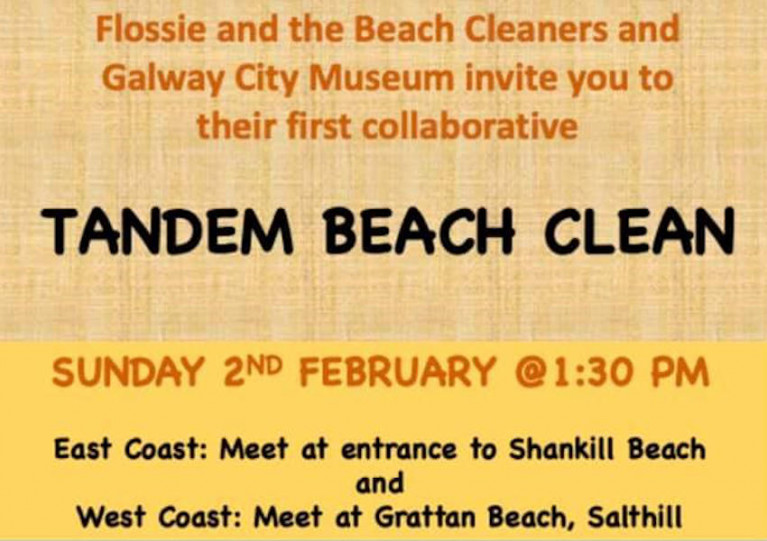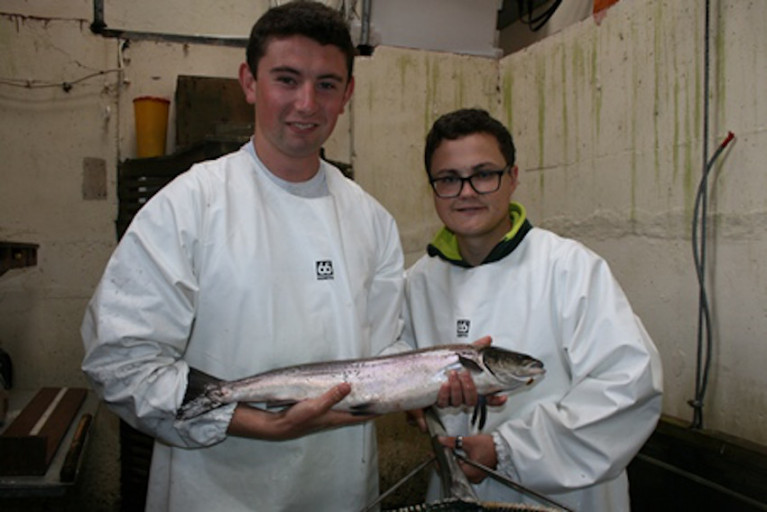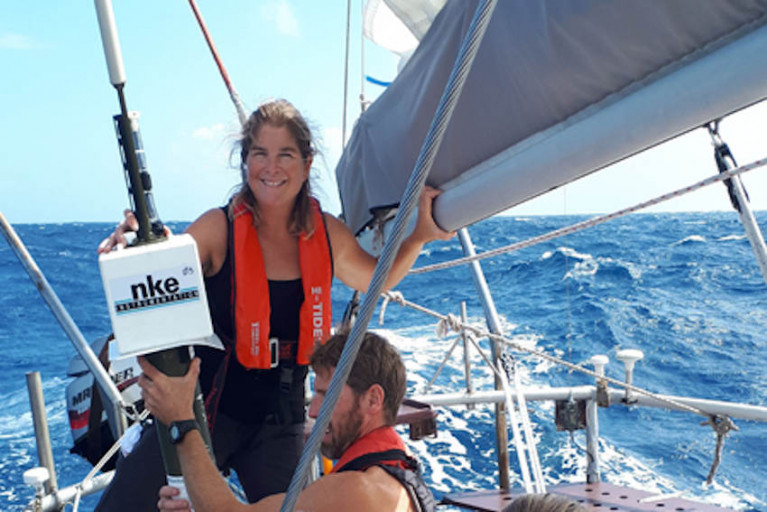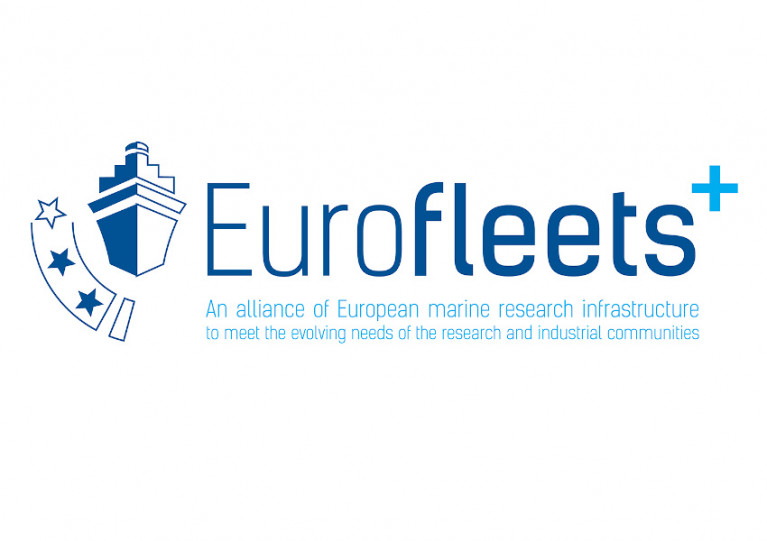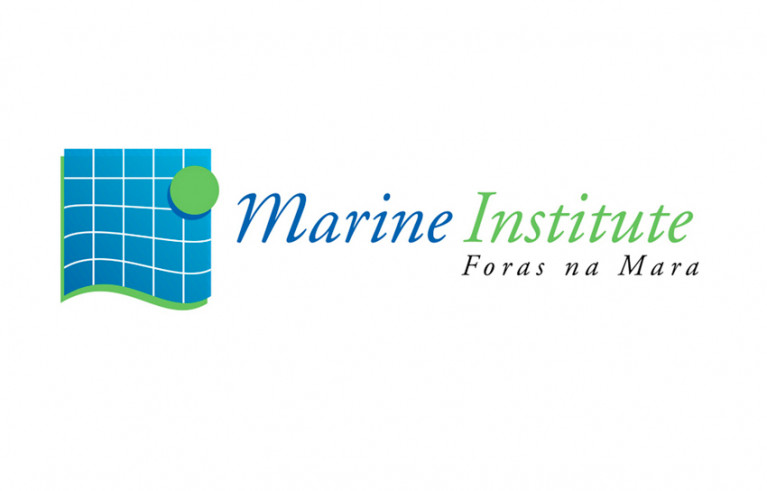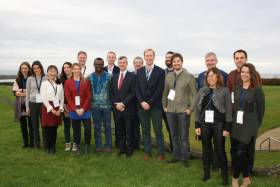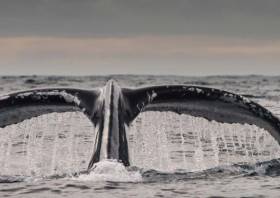Displaying items by tag: Marine Institute
Primary school children across Ireland are being invited to use the power of their imagination to save the ocean from climate change in a new art and writing competition.
The Explorers Pop Art & Creative Writing Competition was launched earlier this week by the Marine Institute’s Explorers Education Programme.
“By bringing science, art and creative writing together, the aim of the ‘ocean superhero’ competition is to cultivate the children's imagination, creating new ideas and solutions when addressing issues of environmental care and climate change,” said Cushla Dromgool-Regan, Explorers Education manager from Camden Education Trust who is co-ordinating the contest.
“The idea of creating an ocean superhero aims to help create a sense of hope for children at a time of adversity in the world, when the impacts of climate change can seem extremely challenging.”
The winners will see their art work and stories showcased as part of the Marine Institute exhibit at SeaFest, Ireland’s largest maritime festival, from 14-17 May.
A shortlist of VIP winning classes will be invited to visit the Marine Institute’s research vessel and its exhibition at Seafest, where they will get to meet world-leading speakers and scientists who are all working towards Ireland’s challenge in responding and adapting to climate change.
The Explorers Education Programme website has more information about the competition, including details of how to enter.
Open Call For 22 Marine Research Vessel Bursaries In 2020
The Marine Institute in collaboration with the Strategic Marine Alliance for Research and Training (SMART) is offering 22 bursaries on dedicated FEAS surveys throughout 2020 on the RV Celtic Explorer and RV Celtic Voyager.
Bursaries include groundfish, acoustic and underwater TV surveys (UWTV) on 13 survey legs between February and December of this year on the shelf waters of the Irish EEZ.
Successful applicants will receive a Student at Sea Bursary at a fixed rate of €95 per survey night.
Participants will receive hands-on training in data collection and sampling techniques, be fully integrated into the survey work programme and make an important contribution to achieving the survey goals for marine science.
In so doing they will gain valuable sea going experience and assist the Marine Institute in building the necessary capacity for offshore research and monitoring.
Applicants should be marine-oriented graduates, postgraduates, researchers or practitioners in marine-oriented enterprises. They must hold current ENG11 medical and Personal Survival Techniques (PST STCW95) certificates, and should have some prior sea-going experience.
Further information on the available bursaries can be found on the SMART website, which also has details of the online application process.
Ireland’s East and West Coasts will compete to collect the most marine litter in a simultaneous beach clean this Sunday 2 February.
The Tandem Beach Clean is being organised by Galway City Museum along with Flossie and the Beach Cleaners, an initiative formed by 12-year-old coastal litter crusader Flossie Donnelly who will be no stranger to Afloat.ie readers.
Volunteers will gather at Grattan Beach in Salthill, Galway and Shankill beach in Co Dublin from 1.30pm this Sunday, and both sides will link up virtually at 2.30pm to compare how much rubbish they’ve collected, as well as the highest number of plastic bottles and tin cans.
There will also be a competition for the oldest item picked up along the shore, and a prize for the most unusual find.
Speaking about the event, Flossie said: “We are so excited that Flossie and the Beach Cleaners, Galway City Museum and the Marine Institute will be taking part in the very first ‘virtual beach clean’.
“Month by month the charity will be organising virtual beach cleans around the coast of Ireland until we have a national virtual beach clean. We are delighted that Galway City Museum and the Marine Institute will be joining us for this exciting event. The East meets the West!”
Harriet Dundon, a Marine Institute graduate intern at Galway City Museum, added: “We are becoming more aware of plastic waste in our ocean, and beach cleans are one way we can help make a difference.
“The museum is delighted to be involved in this national event to raise awareness about marine litter and be the first collaborators with Flossie and the Beach Cleaners on the West Coast.”
Galway City Museum hosts the Marine Institute’s exhibition, Sea Science — The Wild Atlantic, the first of its kind in the country, as previously reported on Afloat.ie.
To take part in either beach clean this Sunday, simply turn up on the day — participants will be provided with equipment for rubbish collection and are encouraged to wear appropriate clothing and footwear.

Students Invited To Apply For Marine Institute’s 2020 Bursary Scholarship Programme
The Marine Institute is inviting marine science undergradutes to apply for a number of work experience placements as part of the 2020 Summer Bursary Scholarship Programme.
In 2020, the programme will offer a number of eight- to 12-week placements for up to 22 undergraduate students.
The programme offers students practical experience in the areas of Marine and Freshwater Fisheries, Salmon Ecology, Environmental Data, Aquaculture, Oceanography, Data Visualisation, Benthic Ecology, Marine Chemistry and Marine Communications, and a new bursary position linking art and science.
The Marine Institute’s Bursary Scholarship Programme has been running for over 30 years, providing essential career development and support, and inspiring the next generation of marine scientists and experts.
A key initiative of the Marine Institute’s new Strategic Plan 2018-2022: Building Ocean Knowledge, Delivering Ocean Services, the programme equips third-level students with the skills to become ocean leaders and marine professionals of the future.
“As well as strengthening skills and knowledge, the Bursary Scholarship Programme enables students to make informed decisions early in their studies about the marine and maritime careers they would like to pursue,” said Helen McCormick, senior lab analyst and Bursary Programme co-ordinator.
“The programme provides undergraduates a unique opportunity to meet fellow students from other universities as well as work with experts in their field helping them form a future network in the marine sector.”
Successful students will receive a scholarship worth €275 per week for the duration of the work placement. Bursars will be based at various locations, including the Marine Institute headquarters in Oranmore Co Galway, the Newport Catchment Facilities in Co Mayo and other locations and ports around the country.
The Bursary Scholarship Programme is aimed at undergraduates of universities, institutes of technology and national institutes for higher education. To participate in the programme, undergraduate students must have completed two years of study in a relevant discipline by the beginning of June 2020.
The Marine Institute says it is committed to supporting a culture of high performance driven by our people, whose skills, experience and passion for the marine are central to the work we perform for government and other stakeholders.
To apply for the 2020 Bursary Programme:
- View the bursary titles available
- Select the two bursary positions that interest you the most and in order of preference
- Complete the application form and return it FAO Helen McCormick, Marine Institute, Rinville, Oranmore, Galway, H91 R673
The application deadline date is Wednesday 12 February.
Galway Family Deploys Argo Float In Atlantic Ocean
The Quinlan-Owens family from Galway gave the Marine Institute a helping hand recently when they deployed an Argo float in the Atlantic Ocean while sailing their yacht Danu.
Vera Quinlan, Peter Owens and their two children Lilian and Ruairi deployed the Argo float en route from Cape Verde to French Guiana as part of their 14-month sailing trip around the Atlantic from Galway to New York.
Vera is a hydrographer for INFOMAR, the national seabed mapping programme, which is jointly managed by the Marine Institute and Geological Survey Ireland.
Thanks to the Quinlan-Owens family from Galway for sharing this video of the deployment of a Marine Institute Argo Float in December.
— Marine Institute (@MarineInst) January 23, 2020
For more on this story please see - https://t.co/yWmgLbTLdD #marine #argofloat #ocean #data #research @EuroArgoERIC pic.twitter.com/5TXeTWZ9io
Argo floats are deployed across the world’s oceans to continuously monitor the ocean and provide essential data to help marine scientists understand oceanic conditions, interactions between the ocean and the atmosphere, as well as long-term climate trends.
The devices distribute real-time information on temperature and salinity up to a depth of 2,000 metres below the ocean's surface.
Measuring the temperature and salinity of the ocean is crucial in better understanding climate change and the role of our oceans on our climate.
Before departing on their sailing voyage in June last year, Lilian and Ruairi showed the Argo float to their classmates at Kilcolgan Educate Together National School. The pupils signed their names on the float, which is now in the Atlantic Ocean and collecting measurements on temperature and salinity.
Measuring the temperature and salinity of the ocean is crucial in better understanding climate change and the role of our oceans on our climate
This data is transmitted via satellite every 10 days for the three to four years of the float’s lifespan and its location can be tracked at digitalocean.ie.
Alan Berry, of ocean science and information services at the Marine Institute, says it usually deploys Argo floats on research surveys carried out in the North Atlantic.
“Vera’s sailing trip offered the opportunity for an Irish Argo float to be deployed much further south, near the equator. We thank Vera and her family for participating in the Argo programme, and to Lilian and Ruairi for sharing this experience with their classmates so they can also learn about the importance of monitoring our oceans.”
As part of the Marine Institute’s participation in the Euro-Argo ERIC programme, 20 Argo floats have been deployed by the Marine Institute in the North Atlantic over the last 10 years, with a sustained deployment of three Argo floats per year since 2015.
The international Argo Programme currently has a network of some 4,000 Argo floats taking measurements in the world’s oceans.
The story of Danu’s 2019-2020 Atlantic circuit will feature in W M Nixon’s up-coming Sailing on Saturday here
Marine Researchers Invited To Apply For EurofleetsPlus Programmes
EurofleetsPlus, the marine research consortium co-ordinated by the Marine Institute, is currently calling for applications from researchers for three programmes.
The first of these, the Ship-time and marine Equipment Application (SEA) Programme Call ‘Regional’, offers fully funded transnational access to 16 research vessels and six pieces of marine equipment to carry out ship-based research activities within any field of marine science.
Applications are welcome from international teams of researchers from academia and industry. Early career and female applicants are particularly encouraged to apply. This call will remain open for the submission of proposals until Tuesday 28 January.
Meanwhile, the Remote Transnational Access (RTA) Programme is providing researchers from all career stages with remote access to samples or data from EurofleetsPlus vessels.
And the Co-Principal Investigator (PI) Programme is specifically aimed at early career researchers, or researchers with no experience in leading a research cruise, to implement their own research together with experienced scientists in EurofleetsPlus scheduled cruises.
Applicants for the RTA and PI programmes are able to apply for all 27 state-of-the-art research vessels offered within EurofleetsPlus, including the RV Celtic Explorer. These programmes are both running calls, which allow the continuous submission of proposals until call closure at 31 January 2022.
For further information on funding conditions, eligibility criteria and application guidelines, visit the EurofleetsPlus website.
Co-ordinated by the Marine Institute, EurofleetsPlus is a unique consortium of research vessels, equipment and scientists supported by 42 marine institutes, universities, foundations and SMEs from 24 countries around the North Atlantic, Arctic, Southern and Pacific Ocean, Baltic, North, Mediterranean, and Black Sea.
EurofleetsPlus has received funding from the European Commission's Horizon 2020 Research and Innovation Programme under grant agreement No 824077.
Ocean Energy Is Greatest Opportunity For Growth Of Blue Economy, Survey Says
Ocean energy is the greatest opportunity for the growth of Ireland’s maritime or ‘Blue’ economy, according to a new survey produced as part of the Our Ocean Wealth Summit.
As the Irish Examiner reports, the survey commissioned by the Marine Institute and PwC says more than 80% of leading voices in the maritime sector are “confident in its future growth potential”, in the words of PwC partner Declan McDonald.
Apart from offshore energy developments in wave and wind power, the survey highlights potential in maritime tourism, aquaculture, sea fisheries, biotechnology and shipping.
The Irish Examiner has much more on the story HERE.
Spanish Shipyard to Build Ireland’s New Marine Research Vessel
The Marine Institute and Spanish shipyard Astilleros Armon Vigo S.A. have signed a contract for the construction of Ireland’s new state-of-the-art marine research vessel, following the completion of the design of the vessel by Skipsteknisk AS of Norway. This is a significant milestone with the build process contracted to complete in 2022.
As Afloat reported previously, the new ship Supporting the Government’s national integrated marine plan, Harnessing Our Ocean Wealth, as well as the national Marine Research and Innovation Strategy, the new 52-metre research vessel will form a critical part of the State’s maritime infrastructure. It will replace the RV Celtic Voyager and will be a sister ship to Ireland’s larger research vessel, the 65-metre RV Celtic Explorer.
The new vessel will support Ireland in addressing some of the research challenges of Brexit and the Common Fisheries Policy, as well as climate-induced impacts on our oceans. It will facilitate service demands under the European Maritime Fisheries Fund (EMFF) including the conservation, management and rebuilding of fish stocks and the long-term sustainable harvesting of marine biological resources. It will greatly enhance the Institute’s many research and data gathering activities in areas like marine biodiversity, marine spatial planning and ocean observation and monitoring. The vessel will also support a diverse range of marine operations, such as maintaining and deploying Ireland’s Marine Data Buoy Network which supports Met Éireann’s daily weather forecasts.
The new research vessel will be a modern, multipurpose, silent vessel, capable of operating in the rough seas of the Irish Exclusive Economic Zone (EEZ). It will be designed to incorporate the latest proven technologies to ensure that it operates as efficiently as possible, ensuring minimal fuel consumption and minimising the vessels environmental impact and carbon footprint.
Welcoming the signing of the contract to construct the new research vessel, Minister for Agriculture Food and Marine, Michael Creed TD said:
“This project, when completed, will ensure that the important work of the Marine Institute, including vitally important fisheries and oceanic research initiatives, which are also important in the context of Climate Action, will be significantly enhanced through the commissioning of a state-of-the-art new fuel-efficient research vessel. I am delighted that my Department has been able to provide the necessary capital funding to the Marine Institute to enable the new vessel to be delivered within the anticipated three-year timeframe.”
Dr Paul Connolly, CEO of the Marine Institute welcomed the signing of the research vessel build contract stating:
“This is an incredibly exciting moment in our ocean science history. The new national research vessel will allow Ireland to make a major leap forward in our understanding of the Atlantic. As we enter the UN Decade of the Ocean (2021 to 2030) it will ensure that Ireland continues to build our ocean knowledge and enhance our scientific understanding.”
“The significantly enhanced capabilities of the new research vessel will support a broad range of ocean stakeholders including policymakers, managers, industry, researchers, educators, students, coastal communities and the public. This knowledge is essential if we are to sustainably manage our oceans and empower Ireland and its people to safeguard and harness our ocean wealth.”
Based in Galway, the vessel will be used by the Marine Institute, other State agencies and Third Level Institutes to undertake fisheries, plankton, oceanographic and environmental research and surveys, as well as student training. It will enable Ireland to continue building on our achievements as leaders in seabed mapping. It will also allow for continued transatlantic surveys with international partners through AORA (Atlantic Ocean Research Alliance) and other collaborations, as well as research survey programmes funded through EU Horizon2020.
The new research vessel will be built at Armon’s shipyard facility in Vigo, Spain. The Spanish shipbuilding company Armon, have a reputation as a builder of highly advanced vessels, with more than 900 ships built and in service throughout the world’s oceans. The yard recently built the RV Svea, a 70-metre research vessel delivered to the Swedish University of Agricultural Sciences.
Mick Gillooly, Director of Ocean Science and Information services, Marine Institute highlighted that the nature of marine equipment has changed significantly since the launch of Ireland’s first research vessel, the RV Celtic Voyager back in 1997.
“This new research vessel will be one of the most advanced marine research vessels in the world. It will provide scientists with state-of-the-art facilities and technologies to undertake crucial research that will deepen our understanding of the oceans.”
The new research vessel will be 52 metres long and will be engineered to endure harsh conditions and the punishing weather encountered in the North-East Atlantic and will be able to spend 21 days at sea. In addition, this new vessel will be a silent research vessel, and will be designed to meet the stringent criteria of the ICES 209 noise standard for fisheries research. It will also support the remotely operated vehicle (ROV) and autonomous underwater vehicle operations, which enable the exploration of our deep ocean down to 3,000 metres.”
Symposium Celebrates 10 Years Of Marine Economics & Policy Research
The 10th Annual Marine Economics Policy Research Symposium, recently held at the Marine Institute’s Oranmore headquarters, provided a forum for researchers, scientists, economists and policy makers to present and exchange views on a wide range of topics.
Organised by the Socio-Economic Marine Research Unit (SEMRU) of NUI Galway’s Whitaker Institute with the support of the Marine Institute, the event was a space to discuss issues from the public perceptions of the oceans and marine spatial planning to marine and coastal tourism.
The 10th annual symposium also showcased the international collaborations that have been established between SEMRU and partner institutes through a number of EU projects.
The Marine Institute’s new chief executive Dr Paul Connolly welcomed the researchers, noting that SEMRU “has played a vital role in establishing a sustainable method of valuing our oceans”.
He added that the unit has “also undertaken complex research initiatives across a broad spectrum of areas, such as fisheries, maritime transport tourism and natural capital accounting”.
“Today, economic evidence is available to show the value — market and non-market — of our ocean resources with Ireland's marine sector recognised by Government and the State as an important national asset,” he said.
SEMRU presented the latest economic figures to Government in June 2019 as part of the Our Ocean Wealth Summit.
The latest figures show that Ireland’s ocean economy had a turnover of €6.23 billion and provided employment for 34,132 people (full time equivalents). The total direct and indirect value of Ireland's ocean economy is estimated by SEMRU to be in excess of €4.2 billion GVA (Gross Valued Added), equivalent to 2% of GDP.
Ireland’s integrated marine plan, Harnessing Our Ocean Wealth, outlines the Government’s target to increase the turnover from our ocean economy to exceed €6.4 billion by 2020 and double its value to 2.4% of GDP by 2030.
The symposium welcomed speakers from the Marine Institute; NUI Galwa; Department of Housing, Planning and Local Government; Údarás na Gaeltachta; Galway-Mayo Institute Technology; Trinity College Dublin; Queen’s University Belfast; and ABPmer.
Top women’s surfer turned marine biologist Dr Easkey Britton was among the international list of speakers whose presentations are available to download from the SEMRU website HERE.
New Online Resources Bring ‘Ireland’s Deep Atlantic’ Into The Classroom
TV documentary Ireland’s Deep Atlantic will feature in new online classroom resources for Junior Cert students, it has been announced.
Ireland’s Deep Atlantic — produced by Sea Fever Productions and supported by the Marine Institute, BAI and the Environmental Protection Agency — sees filmmaker Ken O'Sullivan embark on a series of voyages in the North Atlantic in search of blue whales, sharks and deep-water coral reefs.
O’Sullivan filmed part of the series on board the Marine Institute’s research vessel the RV Celtic Explorer and documented coral reefs at a depth of 3,000 metres using the ROV Holland 1.
The series joins two other Irish-produced and publicly funded TV programmes used to create the new online classroom resources.
Business Studies students will use the series, including video clips of the RV Celtic Explorer and scientists, to learn about consumer behaviour and sustainable development, and the impact of economic growth on society and the environment.
Geography students, meanwhile, will learn about the ‘Real Map of Ireland’ and the importance of Ireland's ocean territory. The students will also learn about the exploitation of water, fish stocks, forestry, and soil and the relationships between the physical world, tourism and transport.
Ken O’Sullivan welcomed the new resources, saying: “It’s just wonderful now to realise that every teenager in Ireland will see our beautiful, fertile oceans and learn not just about the rich life within them, but the impact of human behaviour on our oceans with things like consumer spending habits, marine plastics and also the value of eco-tourism to coastal communities.
“Ireland’s Deep Atlantic is the first documentary to be used in this way and the platform has now been built for RTÉ to host many more publicly funded documentaries in this way for the secondary school education curriculum.”
Teachers and students can access the educational material and the programme clips referenced from the RTÉ Learn website.


























